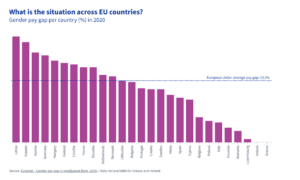EU Pay Transparency Directive: changing pay practices
Building pay transparency measures to create equality of opportunity.

Pay transparency has been a topic gaining traction globally for a while. Many countries across the world including Canada, Chile, France, Germany, Iceland, Lithuania, the UK and the US already have existing salary transparency legislation enacted.
The European Union (EU) is the latest to reach a political agreement on salary transparency. The Pay Transparency Directive will lead the way in addressing pay discrimination, addressing the gender pay gap and ensuring all member states fulfil their transparency obligations.
Pay transparency is being brought to the fore through legislation, and is drawing increasing social engagement. With over 1.5 billion views, #salarytransparency videos are trending on TikTok; content creators are striving to break the taboos associated with salary transparency, create equality of opportunity and support diversity goals.
What is pay transparency?
Pay transparency is the practice of creating an environment of openness in organisations regarding salaries and providing information concerning earnings and pay equity. Pay transparency also allows prospective or current employees to enquire about employee salaries freely and easily without penalisation.
Pay transparency encourages trust and open communication in the workplace, reduces pay discrimination and creates greater wage parity.
Development of pay transparency in the EU:
Pay transparency has become increasingly publicised following the Pay Transparency Directive, approved by the European Council on 15 December 2022. The directive is in the process of formal and final approval by the European Parliament (expected Spring 2023).
The Directive will initiate changes to the framework employers are required to follow regarding pay transparency. The implementation of the Pay Transparency Directive will likely be completed by 2026, 3 years after the conclusion of the vote. Employers will have to:
- Prepare gender pay gap reports.
- Report on and be subject to compulsory pay assessments, in instances whereby the report highlights pay disparities of 5% or more within the organisation.
- Provide evidence of transparent and objective hiring and salary determination processes.
What will the introduction of pay transparency policies mean in practice?
1. Publishing a gender pay gap report
The implementation of the Pay Transparency Directive will positively impact the gender pay gap. Within the first year, organisations that employ more than 250 employees will have to declare any pay gap between men and women. Organisations that employ between 150 and 249 employees will report every three years. Five years after implementation, employers with between 100 and 149 employees will also have to report on the gender pay gap every three years.
As mentioned above, in cases where the published report reveals a gender pay gap above 5% and it cannot be justified why equal pay is not being awarded based on comparative work, employers will be subject to carry out a pay assessment, in cooperation with workers’ representatives.
The nature of these compulsory gender pays gap reports aims to reduce pay discrimination by addressing salary transparency. A report by Eurostat in 2020 revealed on average women are paid 13% less per hour than men across the 27 EU member states. The introduction of the Pay Transparency Directory should vastly reduce the gender wage gap.
The gender pay gap varies across each country within the EU, as shown by the graph below. Businesses that operate across the EU will need to review their regional employment and compensation policies to remain compliant.

(Graph: Eurostat- Gender pay gap in unadjusted form, 2020)
Each member state will need to consider how they monitor and enforce pay transparency legislation if it is not respected. Employees will have the right to seek compensation if employers do not comply and withhold information they are obliged to give concerning equal pay.
2. Requesting information before employment
Before accepting an employment offer, candidates have the legal right to ask about the salary range for the job vacancy. Prospective employers do not have the right to ask about the interviewees’ previous salary or compensation history.
3. Right to access information
Employees will have a right to request information from their employers regarding average pay levels, categorised by sex. This information can be requested for workers who operate within the same remit or job level to provide fair and comparative knowledge. Employees will have the right to request this information regardless of the size of the company.
4. Pay discrimination reduction
The introduction of the Pay Transparency Directive aims to protect workers from being victims of pay discrimination. If employers are found not to be complying with the equal payment obligations, they risk being fined and will have to compensate the employee.
In cases where employees have historically suffered gender pay discrimination, they will able to recover the full amount, equal to that of male colleagues in back pay.
Implementing pay transparency policies:
Using an independent professional organisation to support your business when introducing new employment legislation can help address pay transparency and wage parity in a timely and compliant manner.
Services such as salary benchmarking can help businesses navigate the initial phases required by the Pay Transparency Directive- planning, assessing existing compensation packages and identifying areas for adjustment.
Objective knowledge of local pay rates by job role, industry and experience can help organisations, especially those involved in global assignments enact pay transparency policies and fair salaries for your chosen market in compliance with local legislation.
Mauve offers comprehensive salary benchmarking services, risk and compliance assessments and global payroll solutions. To find out how our global solutions could help your organisation, contact us here.

Global payroll without a local entity: paying overseas employees compliantly
Learn how to pay overseas employees compliantly without setting up a local entity, by engaging global payroll services.


HR and Employer of Record (EOR): supporting employees globally
Discover how HR and Employer of Record (EOR) services support employees globally – ensuring compliance, consistency, and a positive experience across international teams.
